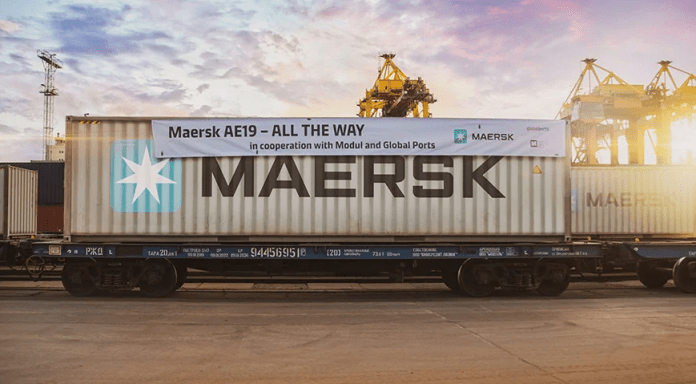Maersk will strengthen its AE19 service with an increase of up to two departures per week aiming to create more supply chain flexibility in Asia/Europe routing options in response to the pandemic’s impact.
The Danish carrier will boost the service’s capacity from 72FEU/train to 144FEU/week, a number which could be slightly bigger due to additional rail cars, with 76FEU/train being the maximum possible capacity, according to a Maersk’s representative.
The AE19 service is a combination of a short-sea and intercontinental rail product between ports in Korea, China and Japan and Northern European ports in Finland, Poland, Germany and Scandinavia. The service covers both westbound and eastbound directions for dry, refrigerated and dangerous cargo.
“The pandemic has triggered some trade bottlenecks in Europe that we can help solve by offering to our customers higher levels of supply chain management e.g. further developing rail into a cost efficient, reliable and scalable mode of transport between continents, creating fall back options which seems to be crucial in crisis situations,” explained Zsolt Katona, Maersk’s managing director in Eastern Europe.
Katona highlighted that both North East Asia and North Europe shippers have increased bookings on the service, pointing out, “boosting AE19 volumes by approximately 75% in April, May and June compared to pre-Covid-19; a trend that will likely improve in the second half of the year.”
Maersk emphasised in its announcement that there are plans underway to scale up the service to daily services if customers’ demand continues on the current track.
AE19 is enabled by TradeLens, a blockchain platform developed by Maersk and IBM, which recently added ICTSI’s network, including 31 terminals worldwide, to its system. TradeLens provides shipping data directly from the source of each party involved in near real-time while connecting this rail corridor directly to its established ecosystem of international transportation service providers.
The AE19 integrates a short-sea connection between Asian origin ports in Korea, Japan or China and the port of Vostochny in the Russian Far East, followed by an intercontinental rail connection across Russia from Nakhodka to St. Petersburg, which takes 11 days.
The last leg of the product is another short-sea connection between St. Petersburg and ports in Finland (Helsinki and Rauma), continental Europe, such as Gdansk (Poland), Bremerhaven (Germany), or Scandinavia.







